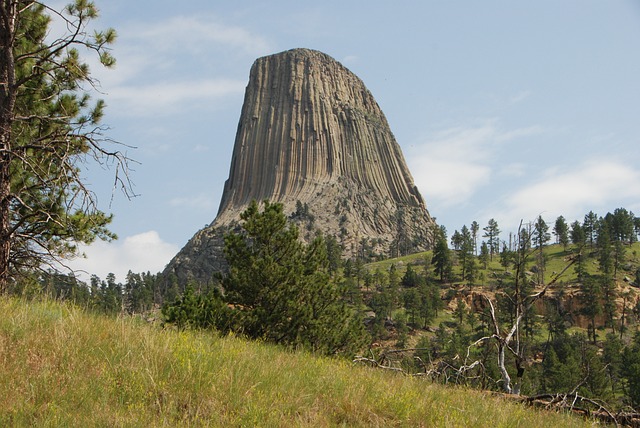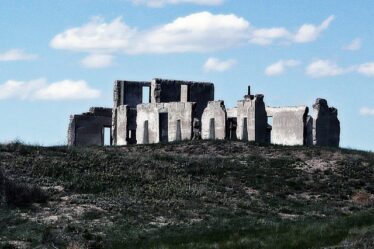
Devils Tower National Monument, located in northeastern Wyoming, is one of the most iconic and geologically intriguing landmarks in the United States. This unique formation rises dramatically 1,267 feet above the surrounding landscape, capturing the imagination of visitors with its striking appearance and rich history. Designated as the first U.S. national monument by President Theodore Roosevelt in 1906, Devils Tower continues to attract adventurers, climbers, and nature enthusiasts from around the world. This detailed guide explores the history, geology, cultural significance, and practical information for visiting Devils Tower National Monument.
Historical Background
Native American Significance
Long before European settlers arrived, Devils Tower was a sacred site for numerous Native American tribes, including the Lakota, Cheyenne, and Kiowa. Known as “Bear Lodge” or “Mato Tipila” in Lakota, the tower is central to various tribal legends and cultural practices. Many Native Americans still hold ceremonies and leave prayer cloths and bundles near the monument, maintaining a spiritual connection to the site.
European Discovery and Preservation
The first documented European exploration of Devils Tower occurred during the Black Hills Expedition in 1875, led by Colonel Richard Irving Dodge. His expedition included a geologist, Henry Newton, who provided one of the earliest scientific descriptions of the formation. Recognizing its unique geological and cultural significance, President Theodore Roosevelt proclaimed Devils Tower as the first national monument on September 24, 1906, under the Antiquities Act.
Geology of Devils Tower
Formation Theories
The exact geological process that created Devils Tower remains a subject of debate among scientists. The most widely accepted theory suggests that it is an igneous intrusion, formed when molten magma was forced into sedimentary rock layers and subsequently cooled and solidified. Over millions of years, erosion removed the surrounding softer rock, exposing the harder columnar basalt that makes up the tower today.
Columnar Jointing
One of the most distinctive features of Devils Tower is its columnar jointing, where the rock has fractured into hexagonal columns. These columns, some of which are over 600 feet tall, give the tower its unique, ribbed appearance. Columnar jointing is a relatively rare geological feature, further adding to the monument’s intrigue.
Activities and Attractions
Climbing
Devils Tower is a premier destination for rock climbers, offering over 200 established climbing routes. The tower’s columns provide natural handholds and footholds, making it a challenging yet rewarding climb. Climbers should be aware of seasonal closures and respect Native American cultural practices, particularly in June, when many tribes conduct ceremonies at the site.
Hiking
- Tower Trail: This 1.3-mile loop trail is the most popular hike, encircling the base of the tower and offering stunning views from all angles. Interpretive signs along the trail provide information about the geology, ecology, and cultural history of Devils Tower.
- Red Beds Trail: A longer 2.8-mile loop, this trail takes hikers through a variety of landscapes, including forests, meadows, and red sandstone formations. It offers expansive views of Devils Tower and the surrounding Belle Fourche River Valley.
- Joyner Ridge Trail: This 1.5-mile trail provides a quieter, less crowded experience, with panoramic views of the tower and opportunities for wildlife spotting.
Ranger Programs
The National Park Service offers a variety of ranger-led programs, including guided walks, talks, and evening campfire programs. These programs provide valuable insights into the natural and cultural history of Devils Tower, enhancing the visitor experience.
Practical Information for Visitors
Getting There
Devils Tower National Monument is located near the town of Hulett, Wyoming. The monument is accessible by car via Wyoming Highway 24. The closest airports are in Rapid City, South Dakota, and Gillette, Wyoming, both about a two-hour drive from the monument.
Entrance Fees and Hours
- Entrance Fees: A per-vehicle fee is charged for entry to the monument. Annual passes and America the Beautiful passes are also accepted.
- Hours of Operation: The monument is open year-round, although hours for the visitor center and other facilities may vary seasonally. The best times to visit are spring, summer, and fall, as winter weather can make access difficult.
Facilities
- Visitor Center: The visitor center offers exhibits, a bookstore, and restrooms. Rangers are available to answer questions and provide information about the monument.
- Campground: The Belle Fourche River Campground offers both tent and RV camping. Reservations are recommended during the busy summer months.
Tips for Visiting
- Respect Sacred Sites: Be mindful of the cultural significance of Devils Tower to Native American tribes. Avoid disturbing prayer cloths and bundles, and consider visiting in months other than June to respect ceremonial practices.
- Stay on Trails: Help preserve the natural environment by staying on designated trails and following Leave No Trace principles.
- Prepare for Weather: Weather in northeastern Wyoming can be unpredictable. Bring layers, sun protection, and plenty of water.
Nearby Attractions
Black Hills
Located just across the border in South Dakota, the Black Hills region offers a wealth of attractions, including Mount Rushmore, Crazy Horse Memorial, and Custer State Park. The scenic drives, hiking trails, and wildlife viewing opportunities make it a perfect complement to a visit to Devils Tower.
Badlands National Park
A short drive from the Black Hills, Badlands National Park features dramatic landscapes of eroded buttes, pinnacles, and spires. The park is home to a variety of wildlife, including bison, bighorn sheep, and prairie dogs.
Spearfish Canyon
This scenic canyon in the Black Hills offers stunning waterfalls, limestone cliffs, and a variety of hiking and fishing opportunities. The 22-mile Spearfish Canyon Scenic Byway is a popular drive, particularly in the fall when the foliage is vibrant.
Conclusion
Devils Tower National Monument is more than just a striking geological formation; it is a place of deep cultural significance, natural beauty, and outdoor adventure. Whether you are a climber seeking a new challenge, a hiker exploring the trails, or a history enthusiast delving into the stories of the past, Devils Tower offers a rich and rewarding experience. Plan your visit to this remarkable landmark and discover the magic of the nation’s first national monument.


